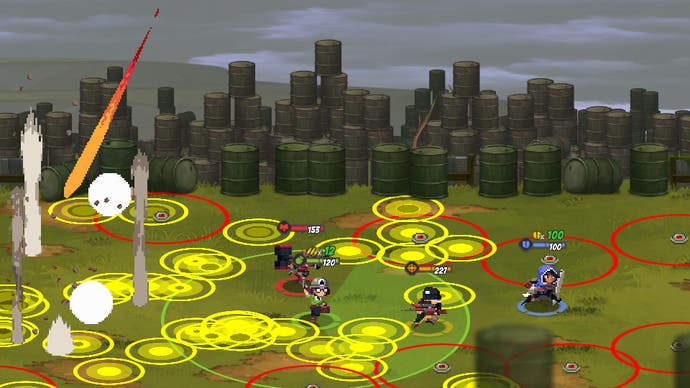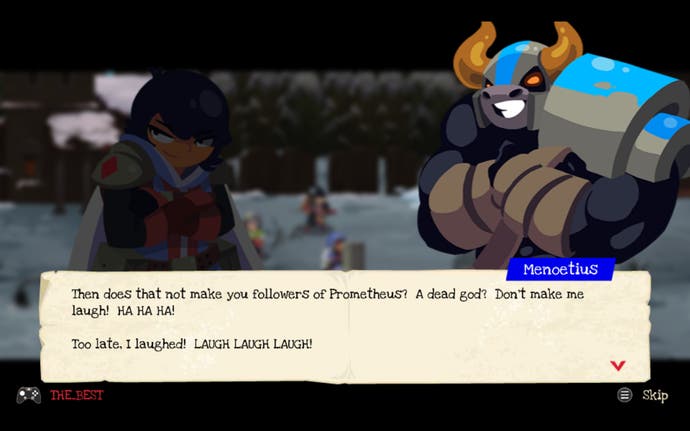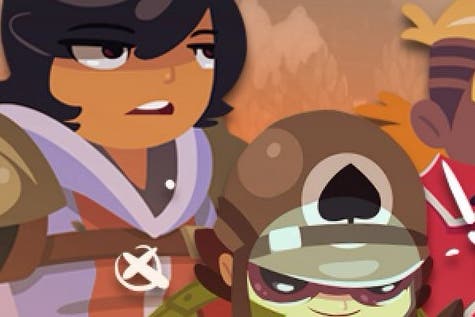Full Metal Furies review
This is for fighting, this is for fun.
Imagine trying to tell to someone in 1995 that the 16-bit aesthetic would one day become a kind of fetishised commodity in videogames. Imagine sitting there, cross-legged in front of their massive CRT telly playing Chrono Trigger with them, and explaining that in the future even though we can make flecks of mud look better than that whole town there, sometimes developers still choose to make games in 2D. On purpose.
The artisanal pixel art in games like Cellar Door's Rogue Legacy, and their new co-op action RPG Full Metal Furies, has come to mean something more than simply 'remember the old times?' though. It's become a shorthand for a slightly more complex concept: a kind of games history remix, where old tropes are celebrated and then turned on their heads, and where genres are expanded and blended with modern awareness. Mother Russia Bleeds did that for the side-scrolling brawler in 2016 with a nihilistic shrug and copy of Vice conspicuously in its back pocket. Full Metal Furies does it with an earnest smile, and an unabashed tendency to draw on the kind of early noughties Flash games with which the Toronto studio first cut its teeth.
Here a four-strong squad of eponymous Furies - read that title carefully to avoid disappointment, Furry enthusiasts - must take down powerful Titans using their combined prowess as fighter, sniper, engineer and tank in the classical tradition of Streets of Rage, Battletoads et al. They're a well-rounded bunch to play, all admirably distinct from one another in the heat of battle in terms of their demands and functions. Which is to say it's deeply gratifying to throw a sentry gun out while unloading your pistol into a plague of Leeches as Engineer Erin, likewise whirling around with a flaming hammer and pulling off showy counters with Alex the Fighter. Triss draws the short straw on Tank duty, handed a shield and somehow expected to enjoy herself as much as the others with it. At a stretch you could call her an analogue of Overwatch's Reinhardt, but slapping enemies about with your shield like an angry chef with a baking tray just doesn't do it like swinging a hammer. As for Meg the near-sighted Sniper, I probably shouldn't find her rather obvious character trait as funny as I do. She presents a tougher challenge than her trio of companions because, as you might expect of a sniper, she's only effective at range, and the screen tends to fill up with foes at an alarming rate.

Here's the rub, though: they're designed to complement each other as co-op companions. The whole game, from top to bottom, is designed with that in mind, to the extent that at one point you even unlock a little bandstand at your camp where the four of you can play musical instruments in real time. What a lovely touch.
It's just that it's quite hard to actually play Full Metal Furies in co-op.
Cellar Door made the call to make this an invite-only game, from the perspective that it's story-led and thus dropping in at random points in someone else's game - or vice versa - undermines the story progression. That makes sense. The developers pulled untold all-nighters telling a tale, and they want you to experience that tale as a group, in order.
So if you click the purchase button knowing a few mates will be up for some 16-bit brawling, yours is a stress-free co-op proposition. What fun you'll have, bashing lumpen monsters around and teeing them up for your friends to finish off, recalling that telepathic connection you first forged in Battletoads, and enjoying that same alley-oop combat loop once again.
If you don't have those like-minded mates who also own the game to call upon though, the outlook is a bit grim. It functions perfectly well as a solo game on a nuts-and-bolts level, so you can play through the whole thing on your own in theory, switching between two characters on the fly so you can at least revive yourself in a pinch. But truthfully, playing this way produces the same feeling that, say, playing Borderlands alone gives you: that you're missing the point.
To Cellar Door's credit, they've set up a Discord channel for matchmaking. I found myself there quite often, feeling like a student wandering the fresher's fair stalls on the lookout for mates while everyone else has gone out in town to spill Apple Sourz shots over each other while they lean in to bellow the chorus of Livin' on a Prayer. Finding a match with someone of comparable level is quite rare, so I played big chunks of Full Metal Furies alone.

I suppose it says a lot about the structure and the mechanical robustness that I was still able to enjoy it on those terms, as a single-player RPG with a big hole in it. Cellar Door throw curveballs of a mechanical and narrative nature at you every five minutes, just to make you grin and keep you guessing. Ostensibly just another level might suddenly reveal itself to be a bullet hell challenge, a quasi-boss fight, or a throwaway dialogue exchange between the central quartet. Even the world map takes many bizarre metaphysical contortions as you explore its extremities further, and although I can't hand-on-heart say I enjoyed the slightly-too-knowing dialogue (which feels like it's visiting from those aforementioned early noughties Flash games) powering the story forwards, I certainly enjoyed the freewheeling spirit of the adventure.
Those are, I suppose, the components of Full Metal Furies' classic brawler remix: ironic chatter and throwing in other genres to make single-stage cameos here and there. Visually, too, there's a clear intention to blend two eras of gaming from opposite ends of the timeline by overlaying pixel art characters over internet comic scenery.
But it's the simpler touches that end up characterising the game more than anything. The coloured shields around enemies which indicate that only a certain character can harm them; the way those shields abruptly change colour during boss encounters, forcing everyone into a frenzied change-up; the slow-burning character and weapon upgrade paths that instil real pride in your characters when they reach new weapon mastery levels; the earworms-only soundtrack.
Those subtle qualities are easily overlooked in a game that's so currently so difficult to play with company as intended, and whose characters talk to each other like they're at a meme recital. But they are indicative of how well its developers grasp the fundamentals of making a retro brawler tick. Every animation frame is spot on, every hit feels right, and every dodge feels outright heroic. Perhaps in the end it's the deliberately modern touches that end up detracting from Full Metal Furies, and the straight-faced mechanical homages to the good old days that work best. Perhaps it's simply the waist-high stumbling blocks placed between the start menu and an actual co-op session. I'm just glad I don't have to explain why I don't love Full Metal Furies to that hypothetical 1995 buddy, who'd blow a gasket at the depth and detail of it.

